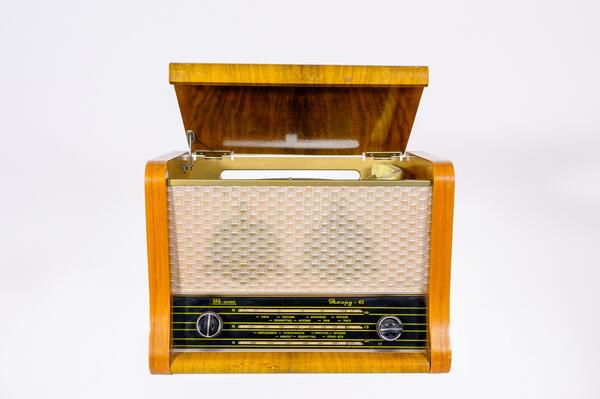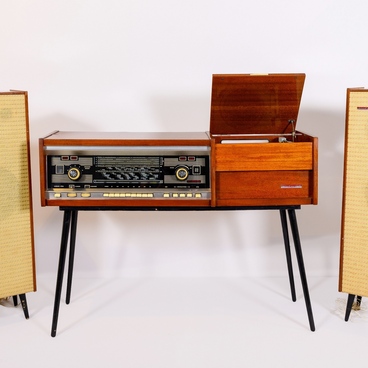A radiogramophone was a device that combined the functions of a radio and a music player. The exposition of the National Museum of the Republic of Mari El exhibits the model Record-61, which was produced from 1961 to 1965 at the Berdsk radio plant in the Novosibirsk region. This factory had been producing radios since the 1940s. Their first model was the 1947 Record-46. After that, the plant also started to produce radios, electric players, and electrophones.
The case of the radiogramophone is made of wood. The top of the front wall is covered with radio fabric, which covers the speakers. On the plastic panel at the bottom, there are control knobs and a scale for tuning radio stations with divisions and marks of the USSR cities — Moscow, Leningrad, Riga, Tallinn, Irkutsk, and others. When the device was turned on, the tuning scale illuminated. The desired radio station was selected by ear, smoothly turning the knob until the sound became clear enough and had no background noise. The radiogramophone “Record-61” could catch programs on short, medium and long waves.
The name of the device — “Record-61” — is located above the control knobs on the left, while on the right, there is the abbreviated name of the manufacturing plant “BRZ” (Berdsk Radio Plant) and the governing body, “ZSSNH” (West Siberian Council of National Economy), which included the plant.
The top cover of the radiogramophone is hinged and fixed on special stands. Underneath there is a disc for records, a turntable head with a needle, a compartment for storing spare gramophone needles, and a switch that controls the speed of the records — 33, 45, or 78 revolutions.
The device worked from a standard 220-volt electrical network. Two loudspeakers produced the sound. A special knob could be used to switch between the radio and player modes. Two other controls allowed adjusting the volume and timbre of the sound. The radiogramophone could work with both external and internal antenna: the jack for its connection was located on the rear wall of the radiogramophone.
The case of the radiogramophone is made of wood. The top of the front wall is covered with radio fabric, which covers the speakers. On the plastic panel at the bottom, there are control knobs and a scale for tuning radio stations with divisions and marks of the USSR cities — Moscow, Leningrad, Riga, Tallinn, Irkutsk, and others. When the device was turned on, the tuning scale illuminated. The desired radio station was selected by ear, smoothly turning the knob until the sound became clear enough and had no background noise. The radiogramophone “Record-61” could catch programs on short, medium and long waves.
The name of the device — “Record-61” — is located above the control knobs on the left, while on the right, there is the abbreviated name of the manufacturing plant “BRZ” (Berdsk Radio Plant) and the governing body, “ZSSNH” (West Siberian Council of National Economy), which included the plant.
The top cover of the radiogramophone is hinged and fixed on special stands. Underneath there is a disc for records, a turntable head with a needle, a compartment for storing spare gramophone needles, and a switch that controls the speed of the records — 33, 45, or 78 revolutions.
The device worked from a standard 220-volt electrical network. Two loudspeakers produced the sound. A special knob could be used to switch between the radio and player modes. Two other controls allowed adjusting the volume and timbre of the sound. The radiogramophone could work with both external and internal antenna: the jack for its connection was located on the rear wall of the radiogramophone.



